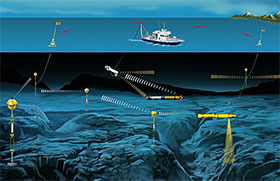Underwater acoustic/optical communications and data connectivity
Improved underwater communications is enabling humans and robots to work together more effectively to solve difficult problems that have not traditionally been amenable to fully automated solutions. Underwater robots differ from their terrestrial, aerial, and space counterparts in that once they are submerged, they cannot employ radio frequencies for telemetry because seawater attenuates electromagnetic radiation over very short ranges. WHOI engineers recently developed and patented a free-space, underwater optical communications system using light to transmit data through water.
This system provides unprecedented bandwidth (1 to 10 Mbit/s) at ranges up to 200 meters. Combined with additional underwater acoustic communication technology pioneered at WHOI, the system can also provide more modest bandwidths over much longer ranges. In a recent experiment, WHOI scientists employed a combination of optical and acoustic modems to conduct sampling and manipulation operations using an untethered ROV. These technologies are enabling a new generation of AUVs and untethered ROVs that can communicate with each other and with controllers on the surface without a physical connection and can offload large data files from autonomous instruments.
Principal Engineers
Norm Farr
Senior Engineer, WHOI
Lee Freitag
Senior Engineer, WHOI
Michael Jakuba
Research Engineer, WHOI

